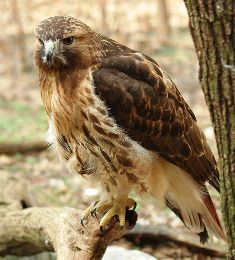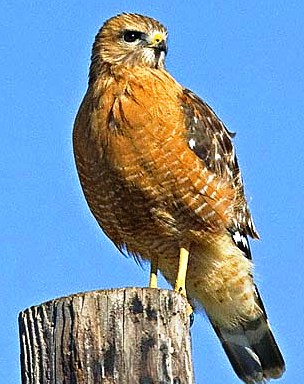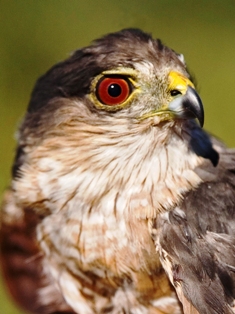Discover Florida Nature
It's time to explore the natural Florida


|
|
|
|
|
 Red-Tailed
Hawk- The red-tailed hawk is the most common member of the
genus Buteo found in the U.S. An opportunistic feeder, this hawk will
take almost anything as prey but it is most successful in pursuit of
rodents. In fact rodents make up about 85% of their diet. Although
common in many areas, the red-tailed hawk is declining in many areas due
to habitat loss, egg shell thinning due to pesticides and especially due
to conflict with humans. The Red-tailed hawk ranges throughout North
America to central Alaska and northern Canada, and south as far as the
mountains of Panama. Although not truly migratory, they do adjust
seasonally to areas of the most areas of the most abundant prey.
Red-tailed hawks are known for their brick-colored tails, but there are
14 subspecies of various colorations, and not all of them have this
characteristic. These birds of prey are also known as buzzard hawks and
red hawks. Red tailed hawks are keen-eyed and efficient hunters.
Red-tails prefer open areas, such as fields or deserts, with high
perching places nearby from which they can watch for prey. But these
birds are adaptable and also dwell in mountains and tropical rain
forests. Hawks have even embraced human habitats. The Red tailed hawk
often perches on telephone poles and takes advantage of the open spaces
along the roadside to spot and seize mice, ground squirrels, rabbits,
reptiles, or other prey. Red-tailed hawks are monogamous and may mate
for life. They make stick nests high above the ground, in which the
female lays one to five eggs each year. Both sexes incubate the eggs for
four to five weeks, and feed the young from the time they hatch until
they leave the nest about six weeks later. Red-Tailed
Hawk- The red-tailed hawk is the most common member of the
genus Buteo found in the U.S. An opportunistic feeder, this hawk will
take almost anything as prey but it is most successful in pursuit of
rodents. In fact rodents make up about 85% of their diet. Although
common in many areas, the red-tailed hawk is declining in many areas due
to habitat loss, egg shell thinning due to pesticides and especially due
to conflict with humans. The Red-tailed hawk ranges throughout North
America to central Alaska and northern Canada, and south as far as the
mountains of Panama. Although not truly migratory, they do adjust
seasonally to areas of the most areas of the most abundant prey.
Red-tailed hawks are known for their brick-colored tails, but there are
14 subspecies of various colorations, and not all of them have this
characteristic. These birds of prey are also known as buzzard hawks and
red hawks. Red tailed hawks are keen-eyed and efficient hunters.
Red-tails prefer open areas, such as fields or deserts, with high
perching places nearby from which they can watch for prey. But these
birds are adaptable and also dwell in mountains and tropical rain
forests. Hawks have even embraced human habitats. The Red tailed hawk
often perches on telephone poles and takes advantage of the open spaces
along the roadside to spot and seize mice, ground squirrels, rabbits,
reptiles, or other prey. Red-tailed hawks are monogamous and may mate
for life. They make stick nests high above the ground, in which the
female lays one to five eggs each year. Both sexes incubate the eggs for
four to five weeks, and feed the young from the time they hatch until
they leave the nest about six weeks later. Red
Shouldered Hawk-
Red Shouldered Hawks are found in moist open forests,
bottomlands and other wet lands throughout most of the U.S. It is
perhaps the most vocal American hawk. The hawk eats a variety of prey
including small mammals, birds, frogs, snakes,
lizards, snails and insects. The
Red-shouldered Hawk is divided into five subspecies. The four eastern
forms contact each other, but the West Coast form is separated from the
eastern forms by 1600 km (1000 mi). The northern form is the largest.
The form in very southern Florida is the palest, having a gray head and
very faint barring on the chest. Although the American Crow often mobs
the Red-shouldered Hawk, sometimes the relationship is not so one-sided.
They may chase each other and try to steal food from each other. They
may also both attack a Great Horned Owl and join forces to chase the owl
out of the hawk's territory. Red
Shouldered Hawk-
Red Shouldered Hawks are found in moist open forests,
bottomlands and other wet lands throughout most of the U.S. It is
perhaps the most vocal American hawk. The hawk eats a variety of prey
including small mammals, birds, frogs, snakes,
lizards, snails and insects. The
Red-shouldered Hawk is divided into five subspecies. The four eastern
forms contact each other, but the West Coast form is separated from the
eastern forms by 1600 km (1000 mi). The northern form is the largest.
The form in very southern Florida is the palest, having a gray head and
very faint barring on the chest. Although the American Crow often mobs
the Red-shouldered Hawk, sometimes the relationship is not so one-sided.
They may chase each other and try to steal food from each other. They
may also both attack a Great Horned Owl and join forces to chase the owl
out of the hawk's territory.  Sharp
Shinned Hawk-
Sharp-shinned hawks can be found throughout much of North America,
including Mexico. In South America, they are found from Venezuela to
northern Argentina. Most of the North American populations migrate to
the southern parts of their range in winter. Sharp-shinned hawks are
forest birds. They are found in pine, fir and aspen forests (among
others). They can be found hunting in forest interior and edges from sea
level to near alpine areas. Sharp-shinned hawks can also be found near
rural, suburban and agricultural areas, where they often hunt at bird
feeders. Sharp-shinned hawks are the smallest hawks in North America.
Males are 24 to 27 cm long and weigh 87 to 114 g. Females are larger,
measuring 29 to 34 cm in length and weighing 150 to 218 g. Males have a
wingspan of 53 to 56 cm and females 58 to 65 cm. Sharp-shinned hawks
have bluish-gray to slate colored upperparts, with darker coloration on
the crown. Their underparts are white with brown bars and their short,
rounded wings are dark above and light below. Females have fewer bars on
the breast, and their upper parts are more brownish. Sharp-shinned hawks
have a short, dark colored, hooked beak and yellow legs and feet. Their
tail is square-tipped when not spread and has three to five dark stripes
with a small white stripe on the tip. Sharp
Shinned Hawk-
Sharp-shinned hawks can be found throughout much of North America,
including Mexico. In South America, they are found from Venezuela to
northern Argentina. Most of the North American populations migrate to
the southern parts of their range in winter. Sharp-shinned hawks are
forest birds. They are found in pine, fir and aspen forests (among
others). They can be found hunting in forest interior and edges from sea
level to near alpine areas. Sharp-shinned hawks can also be found near
rural, suburban and agricultural areas, where they often hunt at bird
feeders. Sharp-shinned hawks are the smallest hawks in North America.
Males are 24 to 27 cm long and weigh 87 to 114 g. Females are larger,
measuring 29 to 34 cm in length and weighing 150 to 218 g. Males have a
wingspan of 53 to 56 cm and females 58 to 65 cm. Sharp-shinned hawks
have bluish-gray to slate colored upperparts, with darker coloration on
the crown. Their underparts are white with brown bars and their short,
rounded wings are dark above and light below. Females have fewer bars on
the breast, and their upper parts are more brownish. Sharp-shinned hawks
have a short, dark colored, hooked beak and yellow legs and feet. Their
tail is square-tipped when not spread and has three to five dark stripes
with a small white stripe on the tip. |
|
|
Advertise | Privacy Statement | Dog Encyclopedia | Video |Contact | Alaska Nature |
|